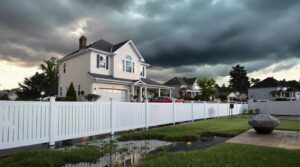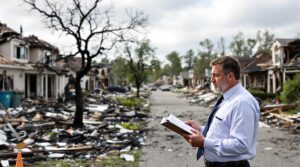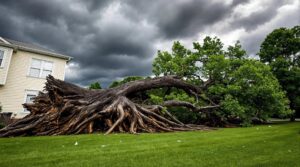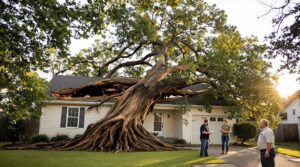Filing a fence damage insurance claim requires careful attention to coverage details and documentation. Most homeowners insurance policies cover fence damage from storms, fallen trees, and vandalism up to 10% of the home's total coverage amount. Successful claims need thorough photographic evidence, maintenance records, and professional damage assessments. Prompt reporting and organized documentation strengthen the likelihood of approval. Understanding policy exclusions and proper claim procedures guarantees the best compensation for fence repairs.
Key Takeaways
- Document all fence damage immediately with detailed photographs, videos, and written descriptions to support your insurance claim.
- Review your homeowner's insurance policy to verify coverage limits, typically set at 10% of your home's total coverage amount.
- Contact your insurance provider promptly after damage occurs and maintain records of all communications throughout the claims process.
- Obtain multiple contractor estimates for repairs and include them with your claim submission for accurate damage assessment.
- Understand covered perils (storms, fallen trees, vandalism) versus exclusions (wear and tear, poor maintenance, floods) before filing.
Understanding Your Fence Coverage
When homeowners face fence damage, understanding their insurance coverage is essential for managing repair costs effectively.
Standard homeowners insurance policies typically cover fence damage caused by specific perils, including storms, vandalism, lightning, fire, and falling trees. However, coverage excludes damage resulting from wear and tear, poor maintenance, or intentional acts.
Insurance providers generally limit fence coverage to 10% of the home's total coverage amount. When evaluating fence value and conducting policy comparison, homeowners should consider both their deductible and potential depreciation costs.
If a neighbor's tree damages the fence during a storm, the homeowner's insurance usually covers the repairs, regardless of the tree's origin. Coverage explicitly excludes damage from floods, earthquakes, termites, and mold.
Understanding these limitations helps homeowners make informed decisions about filing claims and maintaining appropriate coverage levels for their property's specific needs.
Common Types of Covered Fence Damage
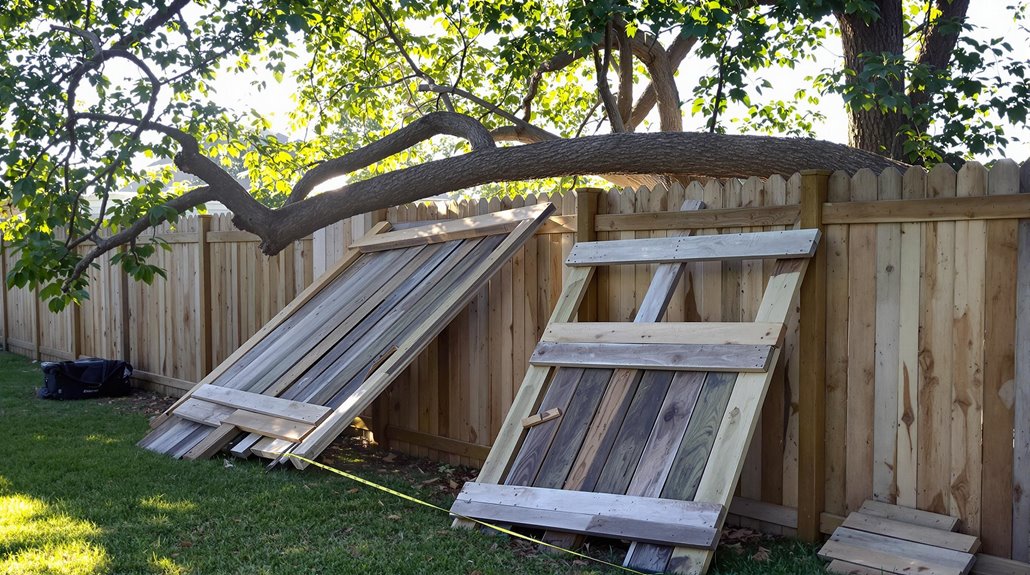
Several common types of fence damage qualify for coverage under standard homeowners insurance policies, with wind-related incidents, fallen trees, and vandalism being among the most frequently claimed perils.
Wind damage from tornadoes and hurricanes falls under the "other structures" portion of policies, while tree damage is typically covered whether the tree originates from the policyholder's property or a neighbor's yard.
Vandalism and accidental damage also receive coverage, provided proper documentation and evidence are submitted.
- Severe storms can violently tear fences from their foundations, leaving properties vulnerable and exposed.
- Fallen trees can crush entire fence sections, creating immediate security risks.
- Acts of vandalism can deface and destroy fencing, compromising both safety and property value.
- Accidental impacts can suddenly leave gaping holes in perimeter security.
Insurance companies require thorough documentation, including photographs and, when applicable, police reports.
Coverage remains subject to policy limits, deductibles, and specific exclusions, such as damage resulting from poor maintenance or gradual deterioration.
Steps to File a Successful Fence Claim
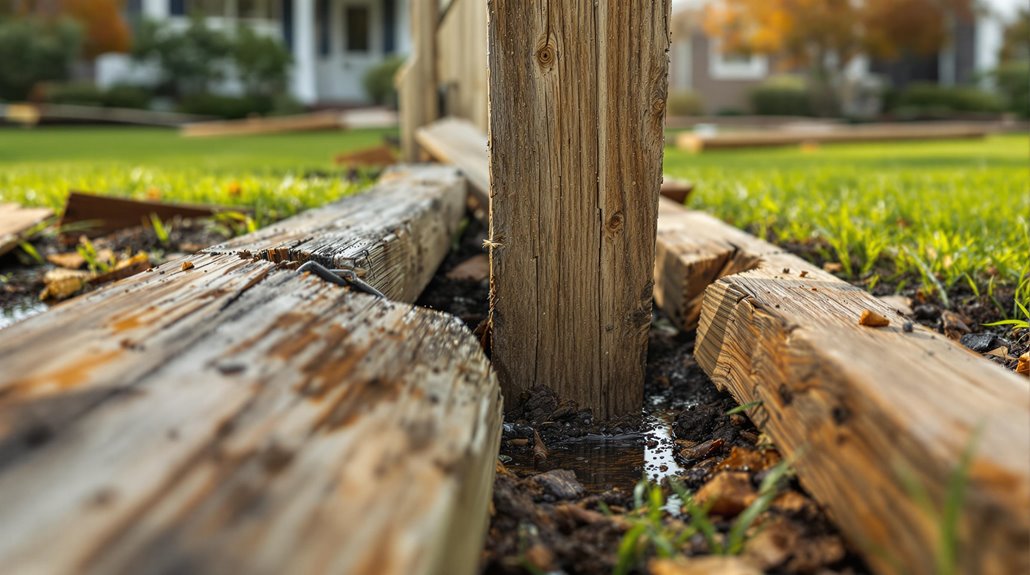
Filing a successful fence damage claim requires careful attention to documentation and proper adherence to insurance protocols. The process begins with a thorough review of policy details, including coverage limits and deductibles, followed by extensive damage assessment and documentation through photographs and videos from multiple angles.
Property owners must promptly contact their insurance provider to initiate the claim filing process, obtaining a claim number and submitting completed forms with supporting documentation. This documentation should include professional estimates, maintenance records, and any relevant weather or police reports. The inclusion of third-party assessments strengthens the claim's validity.
Throughout the process, maintaining organized records of all interactions with the insurance company is essential. Property owners should prepare for adjuster visits by having portable evidence readily available.
Understanding claim processing timelines and staying informed about the claim's status helps guarantee a smooth resolution while demonstrating due diligence in the claims process.
What Your Insurance Won't Cover

Insurance policies typically exclude coverage for common maintenance-related fence damage, including normal wear and tear that occurs over time.
Natural deterioration of fence materials, such as rotting wood or rusting metal, falls outside standard coverage parameters.
Additionally, insurance will not cover damage that results from the homeowner's failure to properly maintain the fence or damage caused by the homeowner's own actions.
Wear and Tear Issues
When homeowners need to file fence damage claims, they should understand that standard insurance policies exclude wear and tear issues.
Regular fence maintenance and damage prevention are essential responsibilities of homeowners, as insurers consider gradual deterioration due to normal use and environmental exposure a maintenance matter rather than an insurable event.
- Neglected wood fences can silently deteriorate beyond repair, leading to costly out-of-pocket replacements.
- Unchecked rust can compromise metal fence integrity, jeopardizing property security.
- Untreated pest infestations can destroy fence structures from within, causing unexpected collapse.
- Deferred maintenance often results in denied claims, leaving homeowners financially vulnerable.
Insurance companies carefully investigate claims to determine whether damage resulted from sudden, covered events or excluded wear and tear conditions.
Documentation of regular maintenance can help support legitimate claims and distinguish them from gradual deterioration.
Natural Deterioration Damage
Homeowners should be aware that natural deterioration of fences falls outside standard insurance coverage parameters.
Insurance policies typically exclude damage resulting from natural decay, including rot, rust, mold, fungus, and termite infestations. These forms of gradual damage are considered part of normal wear and maintenance responsibilities.
Coverage exclusions extend to various environmental factors affecting fences over time. This includes damage from tree roots, landscaping issues, and long-term weathering effects.
Even when structural problems become apparent, insurers generally deny claims related to deterioration that occurs gradually rather than from sudden events.
The policy may cover up to 10% of the house's coverage limit for "other structures," but this applies only to covered perils, not natural deterioration.
Regular maintenance and documentation are essential, as preventable damage rarely qualifies for coverage.
Self-Inflicted Fence Problems
Several types of self-inflicted fence problems fall outside the scope of standard homeowners insurance coverage. Insurance providers consistently deny claims when damage results from the policyholder's actions, whether through neglect consequences or intentional harm.
This includes scenarios where homeowners fail to perform necessary maintenance or deliberately cause damage to their fences.
- Neglecting essential repairs, leading to structural deterioration and eventual collapse
- Causing deliberate destruction that violates policy terms and trust
- Misusing fences beyond their intended purpose, resulting in avoidable damage
- Creating accidental damage through personal actions, such as vehicle collisions
Homeowners must understand that their insurance policies exclude coverage for self-inflicted damage, including negligence, intentional acts, accidental self-caused harm, and fence misuse.
These situations require property owners to bear full responsibility for repair costs.
Maximizing Your Fence Insurance Benefits
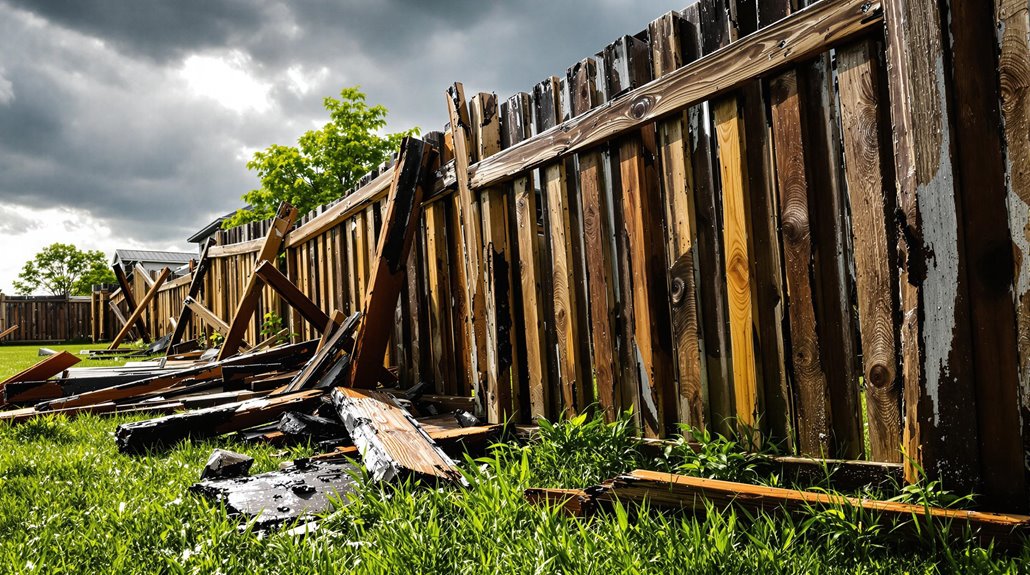
Property owners can optimize their fence insurance benefits through strategic documentation and extensive claim preparation.
Maintaining detailed records of fence maintenance, repairs, and improvements, along with detailed photographs before and after damage occurs, strengthens the claim's validity.
Multiple contractor estimates and proper documentation of all communications with insurance representatives help guarantee maximum coverage within policy limits.
Coverage Strategy Tips
To maximize fence insurance benefits, individuals must implement a strategic approach that combines proper maintenance, documentation, and policy understanding.
Regular fence maintenance tips include inspecting for wear, addressing repairs promptly, and maintaining protective coatings. Selecting durable materials like vinyl or wrought iron can positively impact insurance terms while providing long-term value.
- Protection Priority: Guarantee extensive coverage by incorporating fencing into existing homeowners insurance policies.
- Documentation Diligence: Maintain detailed records of repairs, improvements, and regular maintenance activities.
- Material Mindfulness: Choose high-quality, weather-resistant materials that demonstrate commitment to property protection.
- Strategic Assessment: Regularly evaluate insurance coverage against current fence value and replacement costs.
Understanding policy specifics and maintaining open communication with insurance providers helps homeowners optimize their coverage while potentially securing more favorable terms.
Documenting Fence Claims Successfully
When filing fence damage claims, thorough documentation serves as the cornerstone for successful reimbursement and swift claim processing. Property owners should meticulously photograph and video record all damage from multiple angles, while maintaining detailed notes about the incident's timing and circumstances.
Essential documentation includes police reports for vandalism, weather records for storm damage, and proof of regular fence maintenance. Property surveys help establish boundary responsibilities, while installation documents verify proper construction methods.
When submitting claims, homeowners must provide a complete package containing damage descriptions, cost estimates, and all supporting evidence. Proper documentation demonstrates damage prevention efforts through consistent upkeep and strengthens the claim's validity.
Insurance companies require this systematic approach to process claims efficiently and determine appropriate compensation levels.
Essential Documentation for Fence Claims
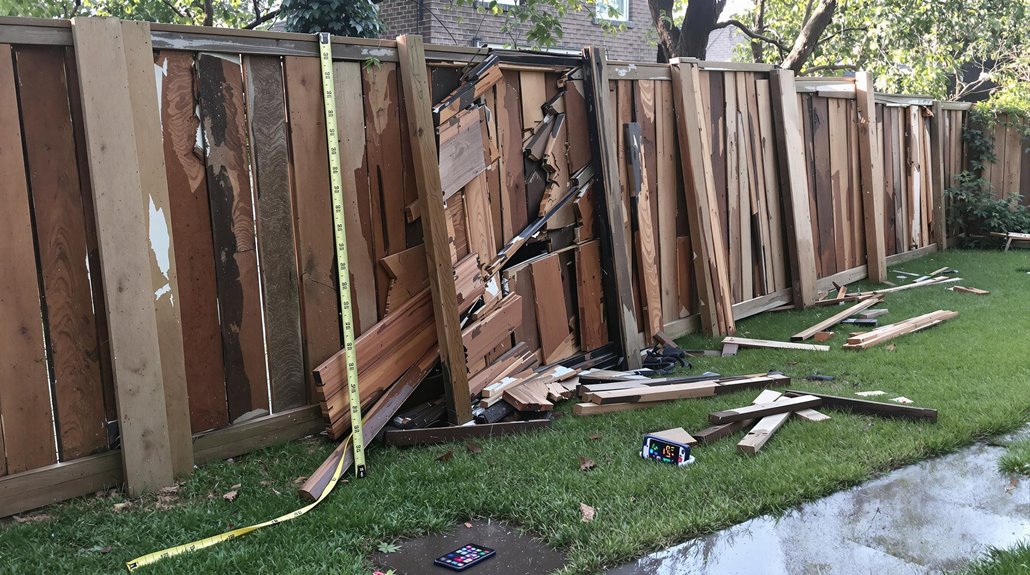
Documentation plays an essential role in successfully filing and settling fence damage claims with insurance companies. Proper documentation strengthens the validity of claims while expediting the settlement process. Insurance providers require thorough evidence to assess damage accurately and determine appropriate compensation within standard claim timelines.
- Pre-repair photographic evidence captures the full extent of fence damage, protecting homeowners from potential claim disputes.
- Professional assessment reports establish credible damage valuations, ensuring fair compensation.
- Insurance policy verification confirms coverage limits and applicable exclusions before filing.
- Systematic records of all claim-related communications maintain a clear audit trail.
Successful claims require meticulous attention to fence maintenance records, damage details, and repair estimates.
Property owners must maintain organized files containing photographs, professional assessments, policy documentation, and communication records. These documents serve as vital evidence throughout the claims process, from initial filing to final settlement.
Frequently Asked Questions
Can I Choose My Own Contractor for Fence Repairs After Insurance Approval?
Homeowners maintain the right to make their own contractor selection for repairs, subject to insurance policy requirements and company approval procedures. This choice remains protected while adhering to established coverage terms.
Will Filing a Fence Damage Claim Increase My Home Insurance Premiums?
Like ripples in a pond, filing a fence claim can affect premiums. Insurance companies conduct premium assessments based on claim history, maintenance factors, and damage circumstances to determine rate increases.
Are Temporary Fencing Repairs Covered While Waiting for Permanent Replacement?
Insurance coverage typically includes temporary repairs made to prevent further fence damage while awaiting permanent replacement, provided proper documentation exists and repairs align with insurer guidelines for emergency mitigation measures.
Does Insurance Cover Fence Damage Caused by My Own Pets?
Standard homeowners insurance does not cover fence damage caused by the policyholder's own pets. While pet liability coverage exists for damage to others' property, damage documentation for personal property remains excluded.
How Long Do I Have to File a Fence Damage Claim?
Insurance claim submission deadlines for fence repair typically range from 24 hours to several months, depending on policy terms. Prompt reporting is essential, and specific timeframes vary by insurance provider and state regulations.
Final Thoughts
While filing a fence damage claim may seem intimidating, proper documentation and understanding of policy coverage guarantees ideal outcomes. Though some homeowners hesitate to file claims fearing premium increases, the cost of fence replacement often greatly exceeds any rate adjustments. By following established claim procedures, maintaining thorough records, and working closely with insurance adjusters, property owners can successfully navigate fence damage claims and restore their property's security and value.
For homeowners dealing with fence damage or any other property damage claims under their homeowners insurance policy, insurance industry insiders and legal experts strongly advise contacting a qualified state-licensed public adjuster. Public adjusters work exclusively for policyholders, not insurance companies, serving as dedicated advocates throughout the claims process. These state-licensed professionals help navigate complex insurance policies, identify hidden damages often unknown to policyholders, thoroughly document losses, and negotiate with insurance companies to ensure fair settlements while protecting policyholder rights.
The benefits of hiring a public adjuster include maximized claim payouts, expedited claims processing, and reduced stress during the insurance claims process. This allows homeowners to focus on property restoration while experts handle the complexities of their claim. Policyholders interested in discussing their property damage or loss claims can request a no-obligation free consultation with a Public Claims Adjusters Network (PCAN) member public adjuster through our contact page.

